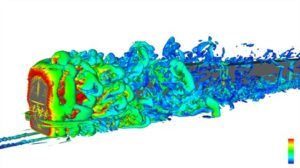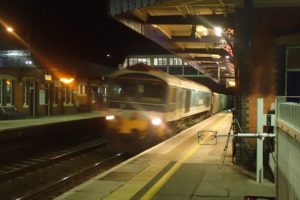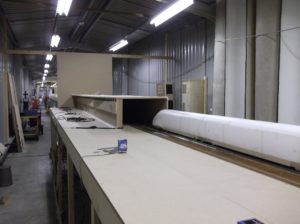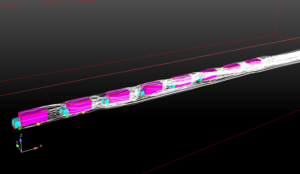
Here at BCRRE one of our best-established themes of research is in aerodynamics. Aerodynamic research is led by Dr David Soper, Lecturer in Vehicle Aerodynamics, and is one of the topics within the Decarbonisation theme.
Why is aerodynamics important? The movement of a train creates a complex aerodynamic flow field around the vehicle. The force required to overcome aerodynamic considerations is known as ‘drag’. As train speeds increase, aerodynamic drag is the dominant force resisting the train’s movement. To overcome these resistive forces requires large amounts of energy, and thus fuel. Improvements in the aerodynamic efficiency of a train can lead to significant reductions in the amount of fuel required, helping to meet decarbonisation targets – whether this is fuel on board a diesel train or electricity supplied from the overhead wires. What is interesting about this, especially in the context of ‘aerodynamics’ which people generally only associate with high speed vehicles, is that these effects are not only apparent for high speed passenger trains but also slower moving freight trains, which are traditionally highly bluff shaped vehicles designed with little aerodynamic consideration.

David and his group’s research is to understand these key aerodynamic parameters and to carry out either full or model scale experiments or train modelling simulations using computational fluid dynamics (CFD), leading to better train and infrastructure design, which in turn leads to less fuel consumption and greater efficiency.
The aerodynamics of passing trains create other important effects as well as drag. The highly complex and turbulent aerodynamic flows that trains produce can create safety issues when interacting with objects nearby. These include passengers waiting on platforms, trackside workers, railway infrastructure (such as noise barriers and hoardings), or local wind conditions which may result in train instabilities (which in the worst-case scenario can lead to overturning).

There are also issues related to pressure waves created as a train enters into a tunnel. It’s possible that these pressure waves can cause effects ranging from aural discomfort for passengers (popping ears) to micro-pressure waves which exit the tunnel as sonic booms.
How do we carry out this research? Much is done in the field, using anemometers and pressure probes which detect changes in air velocities and pressure, allowing us to measure the effects of aerodynamic flows and understand the implications. Late last year we celebrated the reopening of our unique Transient Aerodynamic Investigation (TRAIN) facility after it received a £1.5m renovation and upgrade as part of the UKCRIC project. The rig is made up of an instrumented 150m long track which allows David and his researchers to fire models at speeds of up to 80m/s (close to 180mph) to examine a whole range of different aerodynamic effects including slipstream development and pressure effects, or crosswind effects under a variety of wind conditions. This makes for particularly interesting projects, including recent work on tunnel portals for HS2, the effects of crosswinds on vehicles, and the aerodynamic features of slab track versus ballasted track.

Not every project is rail-related: one recent project has been to look at the aerodynamics of platooned lorries. David explains, “A platoon of lorries acts, aerodynamically, very much like a freight train, meaning results are applicable to rail conditions as well as road and we can learn more about the behaviour of trains.”

For more details on aerodynamics at BCRRE and the TRAIN rig, contact David and check out our website at www.birmingham.ac.uk/research/railway/research/aerodynamics.aspx

1 thought on “Not feeling the pressure with aerodynamic research at BCRRE!”